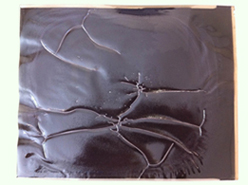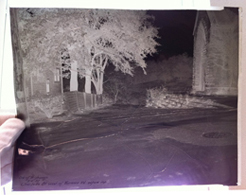By Angela Vanderbilt
The project is off to a great start after the first week, with progress made on identifying the percentage of nitrate negatives in the collection, meeting with Robin Imaging Services – the contracted vendor that will be digitizing the negatives and prints – and deciding on what metadata will be captured during scanning to build the online collections.
With help from Lauren Fink, ARB’s student worker, I gathered from archival storage the 32 boxes containing the City Engineer’s negatives and prints and began surveying the collection to determine the percentage of cellulose nitrate vs. cellulose acetate negatives present. This survey also allowed me to get a quick idea of the level of deterioration which may have already occurred within the collection. For the most part, the nitrate negatives are in good condition, and Robin Imaging is confident that all negatives can be scanned. Unfortunately, however, some of the acetate negatives have reached the “vinegar syndrome” stage, which can place other “healthy” negatives at risk for deterioration. Vinegar Syndrome is the point of deterioration when the negatives start to produce acetic acid which has an acidic odor similar to vinegar. The negatives become brittle and begin to curl or warp easily. The layers of the negative base start to separate at this point, which results in bubbles and “channeling” that resembles a web or vein-like pattern. The image is still retrievable, but the ‘veins’ are visible in the print or scan. It is important to capture the image before much more damage occurs and it is lost completely.
During Week #2, I’ll be sorting through prints and negatives preparing the first batch for delivery to Robin Imaging to begin the digitization process. As scans begin to come back and are approved, I will begin to enter metadata and start building the online collections and make these incredible images of Cincinnati’s urban development accessible on the web. And, as I sort through prints and negatives, I hope to discover the identity of our elusive photographer. We are getting closer! Today I discovered the name “Bill Boone” written in the lower right corner on the back of several prints. A quick search of the Cincinnati city directory for the years 1920 through 1927 revealed a “William H. Boone” whose occupation was proprietor of Kosmos Art Company and who also worked as a draftsman for the Rapid Transit Commission. We could be getting close!
 This project is funded by a grant for $60,669 through the Library Services and Technology Act, administered by the State Library of Ohio.
This project is funded by a grant for $60,669 through the Library Services and Technology Act, administered by the State Library of Ohio.




